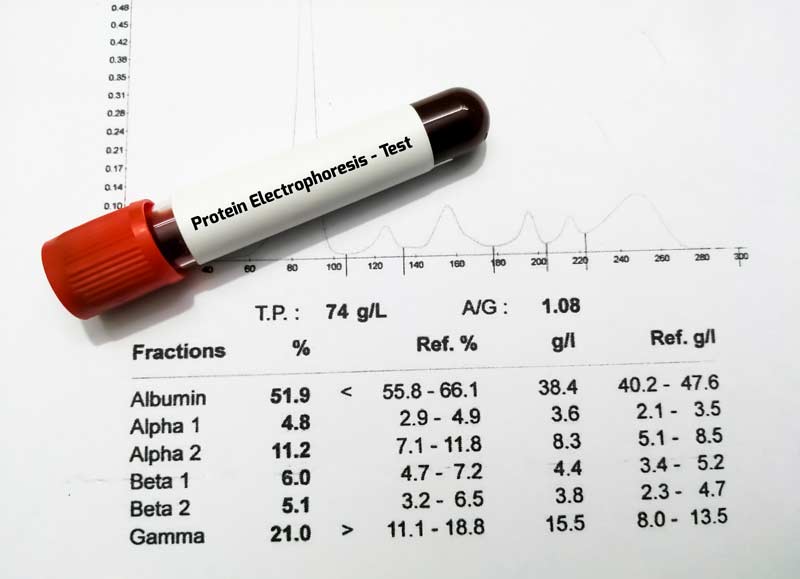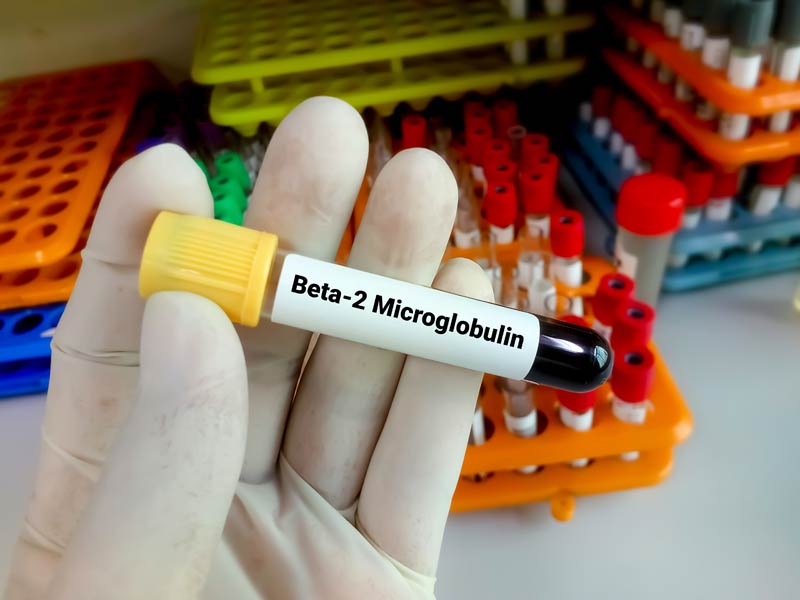EUTOS Score for Chronic Myelogenous Leukemia (CML) online calculator

EUTOS Score predicts outcomes after CML treatments, specifically adjusted for tyrosine kinase treatments.
NOTE! Could be used in newly diagnosed patients before starting therapy prior to discussions regarding prognosis and treatment options.
Maximum distance palpable below costal margin:
Cm
Inches
| EUTOS Score | Risk category | 5 year progression-free survival* and CCyR at 18 months* | Likelihood of NOT achieving CCyR |
|---|---|---|---|
| 0 | 0 | 0 | 0 |
For assessment based on EUTOS Score only requires two values, which can be clinically detected prior to completing a bone marrow biopsy
- ““Basophil” is basophils as a percentage of peripheral blood leukocytes, and
- “Spleen” is spleen size palpable below left costal margin, in cm.
Formula:
- EUTOS Score = (7 × basophil) + (4 × spleen), where
- “Basophil” is basophils as a percentage of peripheral blood leukocytes, and
- “Spleen” is spleen size palpable below left costal margin, in cm.
Probability of not achieving complete cytogenic response (CCyR) at 18 months = x / (1 + x), where x = exp(−2.1007 + 0.0700 × basophils + 0.0402 × spleen size)
The EUTOS (European Treatment and Outcome Study) Score predicts survival and can also be used to predict the probability of complete cytogenetic response at 18 months.
The EUTOS Score has better predictive value than the Sokal Score.
Spleen size estimation is subjective; however, that subjectivity is also included in other CML prognostic scores.
Developed in patients treated with imatinib, so outcomes may not apply with newer generation therapies.
Interpretation:
| EUTOS Score | Risk category | 5 year progression-free survival* | CCyR at 18 months* |
| ≤87 | Low | 90% | 86% |
| >87 | High | 82% | 66% |
*Response rates based on imatinib treatment only.
CCyR, complete cytogenetic response rate.
Can only be applied to a newly-diagnosed patient before starting therapy and Estimates response to therapy to, and survival on, the reference TKI (tyrosine kinase inhibitor) imatinib.
The original derivation of the EUTOS Score came from a retrospective analysis of 1,223 European patients in the European Leukemia Network CML registry. All patients were treated with first generation TKI imatinib and divided into a learning cohort and a validation cohort. The prediction was based on a surrogate endpoint for survival of complete cytogenetic response at 18 months, but was found to also predict progression-free survival (PFS).
An attempt to validate the score by a single institution found that the score was not predictive for survival (Jabbour 2012). There are six major studies showing the EUTOS score predicts outcomes (Hoffman 2012, Hoffman 2013, Tiribelli 2012, Breccia 2012, Uz 2013, Yahng 2012) and three studies showing that it does not (Marin 2011, Jabbour 2012, Yamamoto 2014).
The EUTOS Score continues to evolve, with recent data from Pfirrmann et al (2016) showing that an EUTOS Long-Term Survival Score (ELTS) differentiated probability of death due to CML better than the original EUTOS Score.
One of the conservative strategy is to treat low-risk patients with imatinib and reserve newer-generation TKIs for high risk patients.
Literature:
Hasford J, Baccarani M, Hoffmann V, Guilhot J, Saussele S, Rosti G, Guilhot F, Porkka K, Ossenkoppele G, Lindoerfer D, Simonsson B, Pfirrmann M, Hehlmann R. Predicting complete cytogenetic response and subsequent progression-free survival in 2060 patients with CML on imatinib treatment: the EUTOS score. Blood. 2011 Jul 21;118(3):686-92. doi: 10.1182/blood-2010-12-319038. Epub 2011 May 2. https://pubmed.ncbi.nlm.nih.gov/21536864/
Hoffmann VS, Mayer J, Turkina AG, Hellmann A, Indrak K, Steegmann JL, Zaritskey A, Colita A, Lindoerfer D, Baccarani M. EUTOS score is also valid in CML patients not involved in clinical studies. Blood 2012;120:Abstract 3759. https://ashpublications.org/blood/article/120/21/3759/86000/EUTOS-Score-Is-Also-Valid-in-CML-Patients-Not
Hoffmann VS, Baccarani M, Lindoerfer D, et al. The EUTOS prognostic score: review and validation in 1288 patients with CML treated frontline with imatinib. Leukemia 2013;27:2016–22. https://pubmed.ncbi.nlm.nih.gov/23752173/
Tiribelli M, Bonifacio M, Calistri E, et al. EUTOS score identifies cases with poor outcome in patients with early chronic phase chronic myeloid leukemia, though not predictive for optimal response to imatinib. Blood 2012;120:Abstract 3778. https://ashpublications.org/blood/article/120/21/3778/86223/EUTOS-Score-Identifies-Cases-with-Poor-Outcome-in
Breccia M, Finsinger P, Loglisci G, Latagliata R, Mancini M, Salaroli A, Serrao A, Zacheo I, Alimena G. The EUTOS score identifies chronic myeloid leukeamia patients with poor prognosis treated with imatinib first or second line. Leuk Res 2012;36:e209–10. https://pubmed.ncbi.nlm.nih.gov/22770911/
Uz B, Buyukasik Y, Atay H, et al. EUTOS CML prognostic scoring system predicts ELN-based ‘event-free survival’ better than Euro/Hasford and Sokal systems in CML patients receiving front-line imatinib mesylate. Hematology 2013;18:247–52. https://pubmed.ncbi.nlm.nih.gov/23540886/
Yahng SA, Jang EJ, Choi SY, et al. Comparison of Sokal, Hasford and EUTOS scores in terms of long-term treatment outcome according to the risks in each prognostic model: a single center data analyzed in 255 early chronic phase chronic myeloid leukemia patients treated with frontline imatinib mesylate. Blood 2012;120:Abstract 2794.
Marin D, Ibrahim AR, Goldman JM. European Treatment and Outcome Study (EUTOS) score for chronic myeloid leukemia still requires more confirmation. J Clin Oncol 2011;29:3944–5. https://pubmed.ncbi.nlm.nih.gov/21900102/
Jabbour E, Cortes J, Nazha A, O’Brien S, Quintas-Cardama A, Pierce S, Garcia-Manero G, Kantarjian H. EUTOS score is not predictive for survival and outcome in patients with early chronic phase chronic myeloid leukemia treated with tyrosine kinase inhibitors: a single institution experience. Blood 2012;119:4524–6. https://pubmed.ncbi.nlm.nih.gov/22431574/
Yamamoto E, Fujisawa S, Hagihara M, et al. European Treatment and Outcome Study score does not predict imatinib treatment response and outcome in chronic myeloid leukemia patients. Cancer Sci. 2014;105(1):105-9. https://pubmed.ncbi.nlm.nih.gov/24450386/
Pfirrmann M, Baccarani M, Saussele S, et al. Prognosis of long-term survival considering disease-specific death in patients with chronic myeloid leukemia. Leukemia. 2016;30(1):48-56. https://pubmed.ncbi.nlm.nih.gov/26416462/
Complete the associated clinical case simulation:
Register on our website right now to have access to more learning materials!
Baseline Cardiovascular Risk Assessment in Cancer Patients Scheduled to Receive Cardiotoxic Cancer Therapies (Anthracycline Chemotherapy) – Online Calculator
Baseline cardiovascular risk assessment in cancer patients scheduled to receive cardiotoxic cancer therapies (Anthracycline Chemotherapy)…
National Institutes of Health Stroke Scale (NIHSS) – Online calculator
The National Institutes of Health Stroke Scale (NIHSS) is a scale designed to assess the…
Charlson Comorbidity Index (CCI) Online Calculator
Charlson Comorbidity Index predicts 10-year survival in patients with multiple comorbidities.
Multiple Myeloma Diagnostic Criteria – Online Calculator
Revised Multiple Myeloma International Staging System (R-ISS) Online Calculator
Revised Multiple Myeloma International Staging System (R-ISS) – prognostication tool for myeloma patients based on…
Multiple Myeloma International Staging System (ISS) Online Calculator
Multiple Myeloma International Staging System (ISS) prognosticates the severity of multiple myeloma based on routinely…











